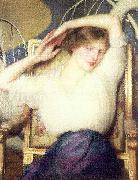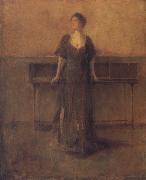
Oil On
Canvas, Real Flavor of Old Masters
|
Paxton, William McGregor
|
|||
|
|
|||
| American Painter, 1869-1941 was an American Impressionist painter. Born in Baltimore, the Paxton family came to Newton Corner in the mid-1870s, where William's father James established himself as a caterer. At 18, William won a scholarship to attend the Cowles Art School, where he began his art studies with Dennis Miller Bunker. Later he studied with Jean-L??on G??rôme in Paris and, on his return to Boston, with Joseph DeCamp at Cowles. There he met his future wife Elizabeth Okie, who also was studying with DeCamp. After their marriage, William and Elizabeth lived with his parents at 43 Elmwood Street, and later bought a house at 19 Montvale Road in Newton Centre. Paxton, who is best known as a portrait painter, taught at the Museum School from 1906 to 1913. Along with other well known artists of the era, including Edmund Charles Tarbell and Frank Benson, he is identified with the Boston School. Like many of his Boston colleagues, Paxton found inspiration in the work of the seventeenth-century Dutch painter Johannes Vermeer. Paxton was fascinated not only with Vermeer's imagery, but also with the system of optics he employed. He studied Vermeer's works closely, and discovered that only one area in his compositions was entirely in focus, while the rest were somewhat blurred. Paxton ascribed this peculiarity to "binocular vision," crediting Vermeer with recording the slightly different point of view of each individual eye that combine in human sight. He began to employ this system in his own work, including The New Necklace, where only the gold beads are sharply defined while the rest of the objects in the composition have softer, blurrier edges. | |||
|
|
|||
|
|
Reverie new5/Paxton, William McGregor-358278.jpg Painting ID:: 19795 Visit European Gallery |
1917 Oil on canvas. | |
Height Width |
INS/CM |
||
|
X |
|
||
|
|
|||
|
Frederick Leighton
|
|||
|
|
|||
| 1830-1896 He was an English painter and sculptor. His works depicted historical, biblical and classical subject matter. Leighton was born in Scarborough to a family in the import and export business. He was educated at University College School, London. He then received his artistic training on the European continent, first from Eduard Von Steinle and then from Giovanni Costa. When in Florence, aged 24, where he studied at the Accademia di Belle Arti, he painted the procession of the Cimabue Madonna through the Borgo Allegri. He lived in Paris from 1855 to 1859, where he met Ingres, Delacroix, Corot and Millet. Flaming JuneIn 1860, he moved to London, where he associated with the Pre-Raphaelites. He designed Elizabeth Barrett Browning's tomb for Robert Browning in the English Cemetery, Florence in 1861. In 1864 he became an associate of the Royal Academy and in 1878 he became its President (1878?C96). His 1877 sculpture, Athlete Wrestling with a Python, was considered at its time to inaugurate a renaissance in contemporary British sculpture, referred to as the New Sculpture. His paintings represented Britain at the great 1900 Paris Exhibition. Icarus and DaedalusLeighton was knighted at Windsor in 1878, and was created a baronet eight years later. He was the first painter to be given a peerage, in the New Year Honours List of 1896. | |||
|
|
|||
|
|
Reverie new11/Frederick Leighton-932949.jpg Painting ID:: 37672 Visit European Gallery |
mk127 31x13 Oil on canvas | |
Height Width |
INS/CM |
||
|
X |
|
||
|
|
|||
|
Thomas Wilmer Dewing
|
|||
|
|
|||
| 1851-1938 Thomas Wilmer Dewing Gallery was an American painter working at the turn of the 20th century. He was born in Newton Lower Falls, Massachusetts. He studied at the Acad??mie Julian in Paris, and later settled into a studio in New York City. He married Maria Oakey Dewing, an accomplished painter with extensive formal art training and familial links with the art world. He is best known for his tonalist paintings, a sub-genre of American art that was rooted in English Aestheticism. Dewing's preferred vehicle of artistic expression is the female figure. Often seated playing instruments, writing letters, or engaged in other impassive actions and situated in gauzy, dreamy interiors, the figures remain remote and distant to the viewer. These scenes are infused with a color that pervades the entire picture, setting tone and mood. The ethereal delicacy and subtle color harmonies of Dewing's paintings have not met with universal approval: some feminist critics have lambasted Dewing's work as being misogynistic; he rarely painted anything other than the female figure, vacant of expression, languishing in sumptuous clothing. Tonalism quickly came to be considered outdated with the advent of modernism and abstraction in art, though Dewing was successful in his own day. His art was considered extremely elegant, and has undergone a subtle revival in the last 10 years or so. Dewing was a member of the Ten American Painters, a group of American Impressionists who seceded from the Society of American Artists in 1897. He spent his summers at the art colony in Cornish, New Hampshire. | |||
|
|
|||
|
|
Reverie new12/Thomas Wilmer Dewing-928984.jpg Painting ID:: 39299 Visit European Gallery |
mk146 before 1928 | |
Height Width |
INS/CM |
||
|
X |
|
||
|
|
|||
|
Jean Baptiste Camille Corot
|
|||
|
|
|||
| 1796-1875 Corot Locations French painter, draughtsman and printmaker. After a classical education at the College de Rouen, where he did not distinguish himself, and an unsuccessful apprenticeship with two drapers, Corot was allowed to devote himself to painting at the age of 26. He was given some money that had been intended for his sister, who had died in 1821, and this, together with what we must assume was his family continued generosity, freed him from financial worries and from having to sell his paintings to earn a living. Corot chose to follow a modified academic course of training. He did not enrol in the Ecole des Beaux-Arts but studied instead with Achille Etna Michallon and, after Michallon death in 1822, with Jean-Victor Bertin. Both had been pupils of Pierre-Henri Valenciennes, and, although in later years Corot denied that he had learnt anything of value from his teachers, his career as a whole shows his attachment to the principles of historic landscape painting which they professed. | |||
|
|
|||
|
|
Reverie new16/Jean Baptiste Camille Corot-695974.jpg Painting ID:: 41293 Visit European Gallery |
mk161 Panel | |
Height Width |
INS/CM |
||
|
X |
|
||
|
|
|||










